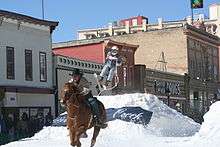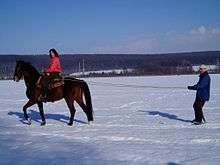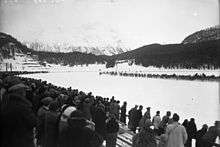Skijoring


Skijoring (pronounced /ˈskiːʃɜːrɪŋ/) is a winter sport where a person on skis is pulled by a horse, a dog (or dogs) or a motor vehicle. It is derived from the Norwegian word skikjøring meaning ski driving.
Dog skijoring
Skijoring with a dog is a sport in which a dog (or dogs) assist a cross-country skier. One to three dogs are commonly used. The cross-country skier provides power with skis and poles, and the dog adds additional power by running and pulling. The skier wears a skijoring harness, the dog wears a sled dog harness, and the two are connected by a length of rope. There are no reins or other signaling devices to control the dog; the dog must be motivated by its own desire to run, and respond to the owner's voice for direction.
Many breeds of dog participate in skijoring. The only prerequisite is a desire to run down a trail and pull, which is innate in many dogs. Small dogs (less than 40 pounds) are rarely seen skijoring, because they do not greatly assist the skier; however, since the skier can provide as much power as is required to travel, any enthusiastic dog can participate. Athletic dogs such as Pointers, Setters and herding breeds take to skijoring with glee, as do the northern breeds, such as Siberian and Alaskan Huskies, Malamutes, Samoyeds, and Inuit dogs; however, any large energetic dog is capable of enjoying this sport. Golden retrievers, giant schnauzers, Labrador retrievers, and many cross-breeds are seen in harness. Pulling breeds work well also such as American bull terriers, Staffordshire terriers, American bull dogs, and mastiffs.
The sport is practiced recreationally and competitively, both for long distance travel and for short (sprint) distances.
Competitions
Since many leashed dogs naturally tend to pull a skier with no training, the sport cannot claim a single country of origin. As a competitive sport, however, it is believed that the first races were held in Scandinavia as an offshoot of the older sport of Pulka. Competitive racing has been taken up in North America while its older cousin Pulka racing has not yet become popular.
Skijor races are held in many countries where there is snow in winter. Most races are between 5 kilometers and 20 kilometers in length. The longest race is the Kalevala[1] held in Kalevala, Karelia, Russia, with a distance of 440 kilometres (270 mi). Next is the River Runner 120[2] held in Whitehorse, Yukon, with a distance of 120 miles (190 km). In the United States and Canada, skijoring races are often held in conjunction with sled dog races. In Scandinavia, skijor racing is tightly associated with the older Scandinavian sport of Pulka. Skijoring races are not normally limited to purebred Northern breed dogs such as the Siberian husky. On the contrary, the top ranked racing teams in the world are German shorthaired pointers, pointer/greyhound mixes, Alaskan huskies, or crosses between these breeds.
Although some races are unsanctioned, held under the sole guidance of a local club, many races fall under one of three international organizations. In the United States and Canada, ISDRA (International Sled Dog Racing Association) sanctions many races. In Europe ESDRA (European Sled Dog Racing Association) provides sanctioning, and the IFSS (International Federation of Sleddog Sports) sanctions World Cup races all over the world, as well as a world championship race every two years. At the IFSS World championship event, skijoring races are separated into men's and women's, and one-dog and two-dog categories.[3] The USA held the world's largest Skijoring event in February 2011 at the City of Lakes Loppet in Minneapolis. 200 Skijoring teams raced in this event which included the first ever National Skijoring Championship.
Equipment
The skijoring belt worn by the skier is a wide waistband which is clipped around the skier's waist, and which may include leg loops to keep it in position. Rock climbing harnesses are also commonly used as skijoring belts.
The sled dog harness can be any of the several types of dog harness commonly used for dogsled racing.
The skijoring line is usually at least 1.5 metres (8 feet) long. A longer line is used for a three-dog team. A section of bungee cord is often incorporated into the line to absorb the impact of the dog's forward motion or a quick stop by the skier. Special quick-release hitches or hooks are available, used so that the skijorer may unhook the dog's lead rapidly.
Techniques and training
The skier uses either a classic diagonal stride cross-country technique, or the faster skate skiing technique. In races, the skate-skiing technique is almost exclusively used. The skis are hot waxed from tip to tail, to avoid slowing the dog team down. Classic skis with grip wax are not used for races but are occasionally used for extended back-country travel.
Skijoring dogs are taught the classic dog sledding commands to start running (hike), turn (gee and haw—right and left respectively in the US), to stop (whoa) and to pass distractions (on by). Training is best done on foot, before the person straps on their skis, to avoid being pulled into objects, like trees or half-frozen creeks.
To participate in races, skijoring dogs must be taught to pass, or be passed by other teams without interfering with them. An overly friendly attempt by one dog to stop and greet another team passing at high speed can be as problematic as a dog that attempts to nip other dogs in passing. A top skijor racing team can pass other teams head-on, without even turning to look at them.
Equestrian skijoring

Equestrian skijoring consists of a team of a single horse, generally guided by a rider, pulling a person on skis who carries no poles and simply hangs onto a tow rope in a manner akin to water skiing. In Saint Moritz, Switzerland, competitions involve a riderless horse, which is guided by the skier. In all cases, the horses have to be trained to accept the presence of ropes and skier behind them and to remain calm in racing conditions.
Skijoring behind a horse is said to have originated as a method of winter travel, but today is primarily a competitive sport.

Historical Background
Skijoring as a sport behind reindeer made its official debut in Stockholm at the Nordic Games of 1901, 1905 and 1909 (http://www.morgedal.com/wp-content/uploads/2017/04/The-beginning-of-the-Winter-Olympics.pdf and https://en.wikipedia.org/wiki/Nordic_Games;https://en.wikipedia.org/wiki/Skijoring_at_the_1928_Winter_Olympics). In 1926, equine skijoring made an appearance at the Chamonix International Winter Sports Week Games (http://blog.americanheritage1.com/blog/bid/103179/The-Magnificent-1924-Chamonix-Winter-Olympic-Games) which set the stage for it’s inclusion as an exhibition sport at the 1928 Winter Olympic Games two years later in St. Moritz, Switzerland (https://en.wikipedia.org/wiki/Skijoring_at_the_1928_Winter_Olympics). In 1976, Denver, Colorado listed skijoring as an exhibition sport in their bid for the Winter Olympics. Denver won the bid, but ultimately turned it down, and skijoring was destined to remain in the shadows. Skijor International, LLC and Skijor USA, a non-profit organization, are working to bring equine skijoring back to the Winter Olympic Games in some capacity in 2026 or 2030 marking 100 years of skijoring history.
The first report of a person being pulled on skis (or wooden boards) by an animal or animals, dogs in this case, was recorded by a Persian historian thousands of years ago in the Altai Mountains of Central Asia, where Russia, China, Mongolia and Kazakhstan come together.
“The first reference to skijoring, where a skier is pulled by an animal, comes from China. During the Yuan and Ming dynasties (1271-1644) “tens of dogs pull a person on a pair of wooden boards. . . galloping on the snow and ice faster than a horse.” I have taken most of this material from A History of Chinese Skiing (in Chinese) published in 1993. The one account from the Tang dynasty, written by the Persian historian, Raschid ed-Din, has been known since 1878 and published numerous times in Western Languages.” p. 23 The Culture and Sport of Skiing: Antiquity to WWII by E. John B. Allen
For hundreds of years, Laplanders have been harnessing reindeer and strapping on Nordic skis as a way to travel across vast snowy expanses, and skijoring (spelled skijøring or skikjoring in Norwegian and meaning "ski driving") is still popular in all Scandinavian countries. Reindeer races are still held in Tromso, Norway; Inari, Finland; and Nadym, Russia. (www.skijor.com/) By 1912, skijoring behind horses was a popular activity in Switzerland, France and the Tatra Mountains of Poland. It did not take long for this activity to cross the Atlantic.
North America
In the early 1900's, equine skijoring found its way to North America. In 1915, it appeared as a recreational activity in Lake Placid, New York and beginning in 1916 was a regular pastime at the Dartmouth Winter Carnival in Hanover, New Hampshire (https://dailyuv.com/profile/435/885512). Equine skijoring has been a tradition at the Steamboat Springs Winter Carnival for 105 years (https://www.adventuresportsnetwork.com/sport/skiing/wont-believe-kids-fun-steamboat-springs/). When World War II ended, men from the 10th Mountain Division, our "Soldiers on Skis", returned home. There were no ski resorts or lifts back then, so their cowboy friends attached a long rope to their saddle horn, and the skier held on as the horse was ridden at high speeds down a long straight-away usually an open field or a snow covered roadway. Mountain towns like Jackson Hole, Wyoming and Steamboat Springs, Colorado took up the sport often running teams of horse, rider and skier side by side down main streets similar to cutter racing. Thus, American races were born.
Today, equine skijoring is a highly specialized competitive sport, where horses accelerate to over 40 mph in just three strides covering a straight track roughly 900' in length. Skiers must navigate a series of jumps and gates and capture rings while being pulled by a rope at speeds up to 60 mph as they accelerate around turns. Jumps can reach 7 feet in height, but are typically lower or roller style which are more friendly to snowboarders who wish to compete. Curved tracks are also used in states such as Montana. The straight course allows the horse to run at top speed down the middle of the course with the skier navigating slalom gates and jumps ranging from two to seven feet high, set on either side of the horse track. The horseshoe-shaped course allows the horse to run on the inside of the track and jumps, set on the outside of the track for the skier, are lower. Competitors often use short skis and modified water skiing towing equipment, though often this is as simple as a single tow rope attached to the saddle horn or the back of a western saddle. Some variants in equipment attach two towing lines to either the back of a saddle or the breastplate on the horse. Timing is typically electronic, with top competitions decided by hundredths of seconds. At races, there are typically three classes of teams: Pro/Open, Sport and Novice and there can often be Women's, Youth, Legend and Snowboard divisions. At times, 100 teams compete each day over a racing weekend, prize pots can reach upwards of $20,000 and a Calcutta, a form of betting pool, is usually held at a local bar. A charitable cause is usually affiliated with each event.
Worldwide Competition
Competitive skijoring races are currently taking place in eight states in the USA (Colorado, Montana, Wyoming, Idaho, Utah, South Dakota, Minnesota, Wisconsin) and as well as in St. Moritz, Switzerland, the region surrounding Zakopane, Poland and Calgary, Alberta, Canada (http://skijorcanada.com). There are different variations of the sport across numerous countries worldwide: France, Denmark, Latvia, Norway, Sweden, Finland, Ukraine and Russia. (http://www.skijorinternational.com) For instance, in the 1950’s skiers were towed by motorcycles or automobiles in races (https://www.eta.co.uk/2015/01/23/worlds-dangerous-sport-skiing-behind-porsche/). In modern day Latvia, skiers are towed in a motocross style event called Twitch ’n Ride sponsored by Red Bull (https://www.redbull.com/lv-lv/events/redbull-twitchnride-2018) and at the Arctic Man competition in Alaska, skiers are towed behind snowmobiles at close to 100 mph (http://www.arcticman.com). Currently, in the United Kingdom, athletes are skijoring on turf or in arenas (https://www.horseboardinguk.org/about-us). In some coastal regions in France and on Caribbean islands, skijoring occurs on beaches.
Today, in Europe, equine skijoring gets the most exposure during White Turf in St. Moritz, Switzerland (https://www.whiteturf.ch). White Turf, an event which features horse racing on snow as well as chariot racing and skijoring, began in 1907 and draws over 35,000 spectators a day. In the United States, Leadville, Colorado has been hosting a competition down its main street since 1949. It was in Steamboat Springs, Colorado that Tom Schroeder, a skier, and “Mugs” Ossman, a horseman, both from Leadville, first witnessed the sport and decided to begin races. Jody Manly, a Leadville skier, designed the course and competed (History of NASJA by Tony Fox). Leadville is known as the “Granddaddy of ‘em All” and Jody Manly as the “Godfather of Skijoring”. He is revered by all who participate in or follow the sport.
Leadville, Colorado hosted their 70th race in 2018. Other popular venues include Helena, Butte, Wisdom, Polson, Bozeman, Red Lodge, Whitefish, Kalispell, and Big Sky, Montana; Hailey and Driggs, Idaho; Jackson Hole, Saratoga, Pinedale, Sundance and Cokeville, Wyoming; Soldier Hollow, Utah; and Silverton, Leadville, Gunnison, Kremmling, Minturn, Pagosa Springs, Ridgway and Steamboat Springs, Colorado which will host its first competitive race separate from the Winter Carnival in 2019. Canterbury Park, Minnesota; Deadwood, South Dakota; and Neosho, Wisconsin are also hosting races now, and there is interest in forming a Northwest regional circuit and revitalizing the Northeast region.
Future Growth
Skijor USA (https://www.skijorusa.com) is currently the leading sporting organization for equine skijoring in the United States and, in 2019 is presenting a circuit with a minimum of 12 races covering three regions, Northern, Central and Southern, plus a Championship Final on the last weekend of the winter race circuit in mid-March. The season begins the first week of January. All SJUSA courses are straight, rules are common and regional points are accrued by teams of horse, rider and skier to advance to the finals. A Tiffany & Company trophy is awarded at the season's end. Skijor USA has coined the phrase “Triple Cross” to define the Western version of equine skijoring which differs from the European version. A Skijor Hall of Fame was established in June 2018 to honor both human and equine participants and contributors to the sport.
Skijor International (http://www.skijorinternational.com) was founded in 2012 by Loren Zhimanskova and promotes the sport of equine skijoring and races of all sizes and affiliations globally from a New York City headquarters. The North American Skijoring Association, or NASJA, the brainchild of Kevin Sisti and Tony Fox who held their first meeting in Red Lodge, Montana, played a significant role in the growth and organization of the sport from 1999 to 2015. From 2004 on, Brooke and Geoff Smith of New London, New Hampshire and Dave Schilz and Scott Ping of Whitefish, Montana played a lead role in NASJA alongside Tony Fox of Los Alamos, New Mexico expanding the sport in the Northeast and the Rocky Mountain West. NAJSA has now disbanded. It was formally replaced by Skijor America (http://skijoramerica.com) in December 2015 and is headquartered in Durango, Colorado.
Motorized skijoring

Skijoring can also take place behind a snowmobile or other small motorized vehicle. The vehicle and driver pull a skier in a manner more akin to the equestrian style, which is more suited for higher speeds than is the dog skijoring style.
Another variant can tow skiers behind an all terrain carrier such as the Bandvagn 206. In this case, several skiers or soldiers can be towed on the same rope. The rope is passed around the skiers ski poles and continues to the next person in line. Skiers then preferably hang on to their ski poles, supported by their arms.
In the media
Skijoring features in the 1998 film Silver Wolf, starring Michael Biehn and Roy Scheider. Skijoring was also talked about in the Castle Films short Snow Thrills, pronounced by Joel Robinson as "she-horring" and described by Tom Servo as "A safe and fun way to blow a Saturday...or a knee!"
Variations of skijoring include snowboarding while hitched to a dog, and "grassjoring," skijoring on grassy fields rather than snow. Related summer sports include bikejoring and canicross.
See also
References
- ↑ "Archived copy". Archived from the original on 2016-03-04. Retrieved 2012-08-30.
- ↑ "Whitehorse Daily Star: NotFound". Whitehorse Daily Star.
- ↑ "History - International Federation of Sleddog Sports". www.sleddogsport.net.
External links
| Wikimedia Commons has media related to Skijoring. |